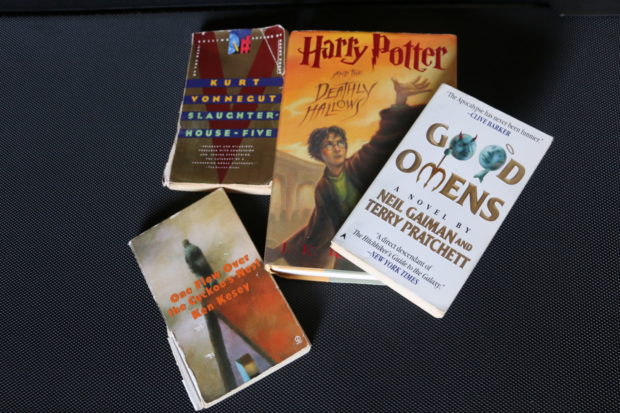
No matter what you think about the truth of the text, it’s hard to deny the Bible is an interesting piece of writing. Featuring love and hatred, war and peace, a man-eating whale and a woman turned to salt, the Bible has action, adventure, and even some romance. | Cristobella Durrette/The Cougar
Regardless of what you think about the truth of the text, it’s hard to deny the Bible is an interesting story. Featuring love and hatred, war and peace, a man-eating whale and a woman turned to salt, the Bible has the adventure of an action movie with a touch of romance.
It’s not a surprise that these stories have proved to be some of the most enduring throughout human history no matter what religion you were raised in. Biblical stories and themes endure in the modern literature. Here are five novels that feature prominent religious themes. If you haven’t read these books, please prepare for spoilers.
One Flew Over the Cuckoo’s Nest by Ken Kesey
Set in a mental asylum in the 1960s, the novel is written from the perspective of Chief Bromden, a patient on the ward who pretends to be a deaf-mute. Chief Bromden details the story of Randle Patrick McMurphy, a Christlike figure despite his tendencies for gambling, womanizing and drinking.
This unlikely messiah brings salvation to the other patients. With his boisterous human spirit, McMurphy rescues his fellow patients from the machinations of the rigid behavior instilled by the head nurse and society outside the ward. The head nurse, Nurse Ratched, is portrayed as the devil in a starched white uniform.
An allegory for Christ’s death, McMurphy eventually sacrifices himself to Nurse Ratched to save the patients from the evils society perpetrates against them.
Good Omens by Neil Gaiman
Putting an alternative spin on the Book of Revelation, the novel tells the story of an unlikely pair working together to stop the approaching Apocalypse. The angel Aziraphale and the demon Crowley, the representatives of Heaven and Hell on Earth, join forces to prevent the Antichrist from bringing about the end of the world.
However, this task is more difficult than the two initially anticipated. The Antichrist has been misplaced.
Utilizing humor to convey messages about the nature of creation, the novel focuses less on the event of the biblical Apocalypse and more on its catalysts and consequences.
Slaughterhouse-Five by Kurt Vonnegut
Despite identifying as a secular humanist, Vonnegut incorporated numerous Christian themes into the novel. The story follows Billy Pilgrim, a young man drafted to serve in WWII.
Billy’s last name — Pilgrim — is a reference to trips taken for religious purposes called a pilgrimage, reflecting the journey Billy goes on through time in the novel. In spite of this name and the fact that he grew up with a crucifix on his wall, Billy was not religious as a child. He goes on to serve as a chaplain’s assistant in the war, during which he is captured as a POW and witnesses the bombing of Dresden.
After returning from the war, Billy becomes “unstuck in time,” experiencing powerful disassociative episodes of PTSD. Living on a moment to moment basis that causes him to travel through the timeline of his life, Billy travels with no warning and in no particular order. This allows Billy to prophesize his own death and further life, associating him with Christ’s prophecy of his death.
Preacher series by Garth Ennis and Steve Dillon
A priest, a gun-toting criminal and an Irish vampire walk into a bar. It sounds like the intro to a poorly written joke, but it’s something that could plausibly happen within the pages of Ennis and Dillon’s acclaimed graphic novel series. The story follows Jesse Custer, a small-town preacher imbued with otherworldly powers that allow him to command anyone or anything with a simple utterance.
Throughout the novels, religion is shown in dark, ultra-violent terms. Chaos reigns, God is nowhere to be found and Jesse Custer is hunting him down to make him pay for his shortcomings. Ennis utilizes characters like Custer to point out the flaws in religion.
Despite a desire to point out its flaws, Preacher does not reject religion outright. The idea of wanting to believe in something, just not necessarily what is presented, is embodied in Genesis, the angel/demon coupling contained in Jesse Custer.
Harry Potter and the Deathly Hallows by J.K. Rowling
Despite receiving backlash from Christians for promoting witchcraft and the occult, the acclaimed series was partially inspired by Christianity. Rowling confirmed the presence of a religious influence in the series after Deathly Hallows was published, saying she didn’t want to give readers a chance to guess what was coming next in the series.
The novel begins with two epigraphs, one of which is drawn from the Quaker Christian tradition. Bible quotes also appear on the tombstones of Harry’s parents and of Professor Dumbledore.
In addition to these overt religious references, Christian themes of death and resurrection are woven into the final chapter of Harry’s story. Like Christ, Harry sacrifices himself and then resurrects from the dead to rescue mankind from evil.
arts@thedailycougar.com
—
“Religious themes found in modern literature” was originally posted on The Daily Cougar
